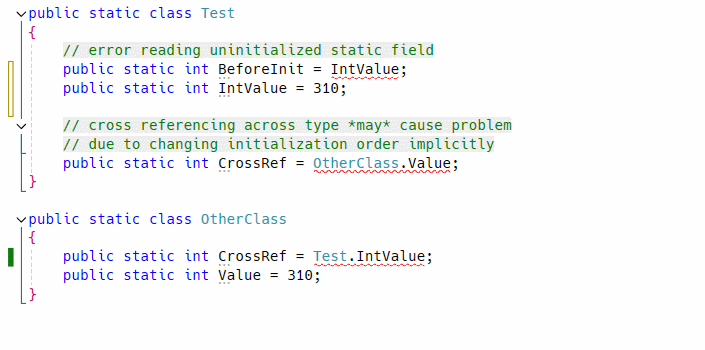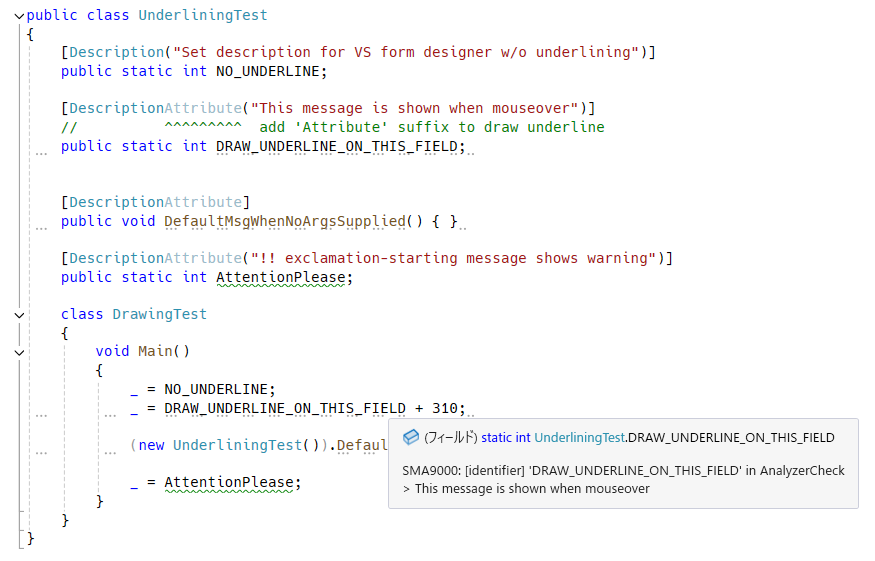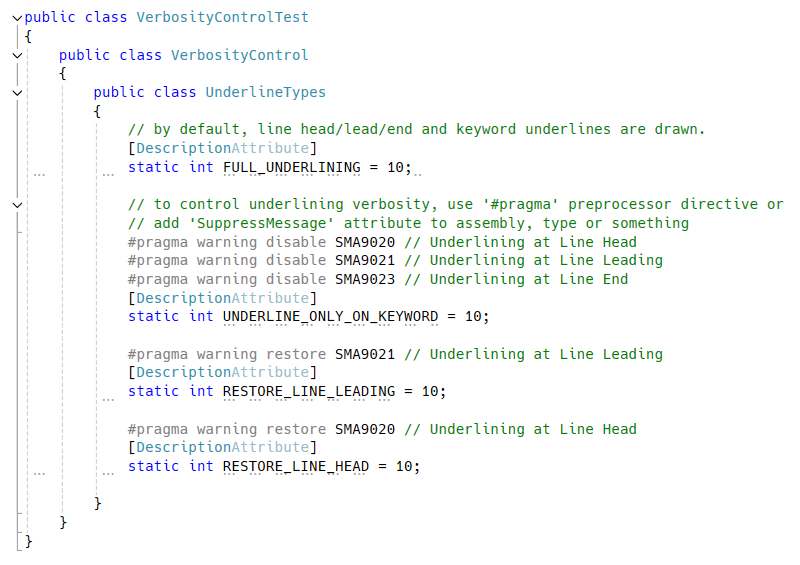SatorImaging.StaticMemberAnalyzer
1.4.0
Prefix Reserved
See the version list below for details.
dotnet add package SatorImaging.StaticMemberAnalyzer --version 1.4.0
NuGet\Install-Package SatorImaging.StaticMemberAnalyzer -Version 1.4.0
<PackageReference Include="SatorImaging.StaticMemberAnalyzer" Version="1.4.0"> <PrivateAssets>all</PrivateAssets> <IncludeAssets>runtime; build; native; contentfiles; analyzers</IncludeAssets> </PackageReference>
paket add SatorImaging.StaticMemberAnalyzer --version 1.4.0
#r "nuget: SatorImaging.StaticMemberAnalyzer, 1.4.0"
// Install SatorImaging.StaticMemberAnalyzer as a Cake Addin #addin nuget:?package=SatorImaging.StaticMemberAnalyzer&version=1.4.0 // Install SatorImaging.StaticMemberAnalyzer as a Cake Tool #tool nuget:?package=SatorImaging.StaticMemberAnalyzer&version=1.4.0
Static Field Analyzer for C# / .NET
Roslyn-based analyzer to provide diagnostics of static fields and properties initialization.
- Wrong order of static field and property declaration
- Partial type member reference across files
- Cross-Referencing Problem of static field across type
TSelfgeneric type argument checker- Annotating / Underlining field, property or etc with custom message


Annotation for Type, Field and Property 💯
There is fancy extra feature to take your attention while coding in Visual Studio. No more need to use Obsolete attribute in case of annotating types, methods, fields and properties.
See the following section for details.

Installation
- NuGet
- https://www.nuget.org/packages/SatorImaging.StaticMemberAnalyzer
-
PM> Install-Package SatorImaging.StaticMemberAnalyzer
Visual Studio 2019 or Earlier
Analyzer is tested on Visual Studio 2022.
You could use this analyzer on older versions of Visual Studio. To do so, update Vsix project file by following instructions written in memo and build project.
Unity Integration
This analyzer can be used with Unity 2020.2 or above. See the following page for detail.
SatorImaging.StaticMemberAnalyzer.Unity/
Cross-Referencing Problem
It is a design bug makes all things complex. Not only that but also it causes initialization error only when meet a specific condition.
So it must be fixed even if app works correctly at a moment, to prevent simple but complicated bug which is hard to find in large code base by hand. As you know static fields will never report error when initialization failed!!
It could be happened when reordering field declarations on refactoring large code base.
class A {
public static int Value = B.Other;
public static int Other = 310;
}
class B {
public static int Other = 620;
public static int Value = A.Other; // will be '0' not '310'
}
public static class Test
{
public static void Main()
{
System.Console.WriteLine(A.Value); // 620
System.Console.WriteLine(A.Other); // 310
System.Console.WriteLine(B.Value); // 0 👈👈👈
System.Console.WriteLine(B.Other); // 620
// when changing class member access order, it works correctly 🤣
// see the following section for detailed explanation
//System.Console.WriteLine(B.Value); // 310 👈 correct!!
//System.Console.WriteLine(B.Other); // 620
//System.Console.WriteLine(A.Value); // 620
//System.Console.WriteLine(A.Other); // 310
}
}
C# Compiler Initialization Sequence
A.Value = B.Other;- // 'B' initialization is started by member access
B.Value = A.Other;// B.Value will be 0 because reading uninitializedA.OtherB.Other = 620;- // then, assign
B.Othervalue (620) toA.Value
A.Other = 310;// initialized here!! this value is not assigned to B.Value
When reading B value first, initialization order is changed and resulting value is also changed accordingly:
B.Other = 620;B.Value = A.Other;- // 'A' initialization is started by member access
A.Value = B.Other;// correct: B.Other is initialized before reading valueA.Other = 310;
Annotating / Underlining
There is optional feature to draw underline on selected types, fields, properties, generic type/method arguments and parameters of method, delegate and lambda function.
As of Visual Studio's UX design, Info severity diagnostic underlines are drawn only on a few leading chars, not drawn whole marked area. So for workaround, underline on keyword is dashed.
Verbosity Control
There are 4 types of underline, line head, line leading, line end and keyword.
By default, static field analyzer will draw most verbose underline.
You can omit specific type of underline by using #pragma preprocessor directive or adding SuppressMessage attribute or etc.

How to Use
To avoid dependency to this analyzer, required attribute for underlining is chosen from builtin System.ComponentModel assembly so that syntax is little bit weird.
Analyzer is checking identifier keyword in C# source code, not checking actual C# type. DescriptionAttribute in C# attribute syntax is the only keyword to draw underline. Omitting Attribute or adding namespace are not recognized.
using System.ComponentModel;
[DescriptionAttribute("Draw underline for IDE environment and show this message")]
// ^^^^^^^^^ `Attribute` suffix is required to draw underline
public class WithUnderline
{
[DescriptionAttribute] // parameter-less will draw underline with default message
public static void Method() { }
}
// C# language spec allows to omit `Attribute` suffix but when omitted, underline won't be drawn
// to avoid conflict with originally designed usage for VS form designer
[Description("No Underline")]
public class NoUnderline { }
// underline won't be drawn when namespace is specified
[System.ComponentModel.DescriptionAttribute("...")]
public static int Underline_Not_Drawn = 0;
// this code will draw underline. 'Trivia' is allowed to being added in attribute syntax
[ /**/ DescriptionAttribute ( "Underline will be drawn" ) /* hello, world. */ ]
public static int Underline_Drawn = 310;
Screenshot
[!TIP]
!-starting message will add warning annotation on keyword instead of info diagnostic annotation.

Unity Tips
Underlining is achieved by using Description attribute designed for Visual Studio's visual designer, formerly known as form designer.
To remove unnecessary attribute from Unity build, add the following link.xml file in Unity project's Assets folder.
<linker>
<assembly fullname="System.ComponentModel">
<type fullname="System.ComponentModel.DescriptionAttribute" preserve="nothing"/>
</assembly>
</linker>
Devnote
Steps to publish new version of nuget package
- update nuget package version in
.props - upload source code to github
- run build action for test
- merge pull request sent from build action
- create github release
- run nuget packaging action to push new version
Learn more about Target Frameworks and .NET Standard.
This package has no dependencies.
NuGet packages
This package is not used by any NuGet packages.
GitHub repositories
This package is not used by any popular GitHub repositories.
| Version | Downloads | Last updated |
|---|---|---|
| 2.0.0 | 1,223 | 12/7/2024 |
| 2.0.0-rc.1 | 56 | 12/2/2024 |
| 2.0.0-beta.2 | 46 | 12/1/2024 |
| 2.0.0-beta.1 | 65 | 11/30/2024 |
| 1.4.0 | 1,996 | 7/29/2024 |
| 1.3.0 | 216 | 7/23/2024 |
| 1.2.1 | 1,291 | 6/2/2024 |
| 1.2.0 | 121 | 6/2/2024 |
| 1.1.0 | 126 | 6/2/2024 |
| 1.0.0 | 135 | 6/1/2024 |
